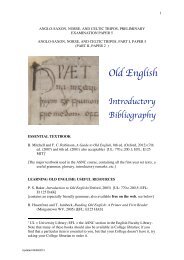Scandinavian history in the Viking age - Department of Anglo-Saxon ...
Scandinavian history in the Viking age - Department of Anglo-Saxon ...
Scandinavian history in the Viking age - Department of Anglo-Saxon ...
You also want an ePaper? Increase the reach of your titles
YUMPU automatically turns print PDFs into web optimized ePapers that Google loves.
<strong>Scand<strong>in</strong>avian</strong> History <strong>in</strong> <strong>the</strong> Vik<strong>in</strong>g Age<br />
is clear that sober, factual documentation was not Photios’ purpose. Text: C. Müller et al., Fragmenta<br />
historicorum Græcorum, vol. V (1883), 162-73 [UL Ff.12.37a]. Transl.: C. Mango, The homilies <strong>of</strong><br />
Photios patriarch <strong>of</strong> Constant<strong>in</strong>ople, Dumbarton Oaks studies 3 (1958), 74-110 [UL 911:01.b.14.4]<br />
[B193] The Byzant<strong>in</strong>e emperor Constant<strong>in</strong>e Porphyrogenitus composed his De adm<strong>in</strong>istrando imperio<br />
‘On imperial government’ around 950 as a guide to statecraft for his son Romanus. It conta<strong>in</strong>s many<br />
valuable observations on <strong>the</strong> tenth-century Rus’, <strong>in</strong>clud<strong>in</strong>g <strong>the</strong> celebrated list <strong>of</strong> rapids on <strong>the</strong> river<br />
Dniepr with both Slavonic and Norse names. Text and transl.: G. Moravcsik and R.J.H. Jenk<strong>in</strong>s,<br />
Constant<strong>in</strong>e Porphyrogenitus, De adm<strong>in</strong>istrando imperio I, Magyar-görög tanulmányok 29 (1949) [UL<br />
711:3.c.90.11], also rev. 2nd edn as Dumbarton Oaks studies 1 (1967) [UL 523:4.c.95.38]; excerpts also<br />
transl. (B1):93-97. Commentary: R.J.H. Jenk<strong>in</strong>s et al., Constant<strong>in</strong>e Porphyrogenitus, De adm<strong>in</strong>istrando<br />
imperio II: Commentary (1962) [UL 711:3.c.90.12]; cf. also A. Toynbee, Constant<strong>in</strong>e Porphyrogenitus<br />
and his world (1973) [UL 523:4.c.95.20]<br />
[B194] The eleventh-century Byzant<strong>in</strong>e adm<strong>in</strong>istrator Kekaumenos is best known for his Strategicon,<br />
but among o<strong>the</strong>r fragments associated with him is a text known as <strong>the</strong> Logos nou<strong>the</strong>tetikos pros basilea<br />
‘Word <strong>of</strong> advice for <strong>the</strong> emperor’, which has a very <strong>in</strong>terest<strong>in</strong>g section on Harald hardrada (E85 ff.)<br />
among <strong>the</strong> Varangian guard <strong>in</strong> Byzantium. Text: B. Wassiliewsky and V. Jernstedt, Cecaumeni<br />
Strategicon et <strong>in</strong>certi scriptoris de <strong>of</strong>ficiis regiis libellus, Zapiski istoriko-filologieskogo fakulteta Imp.<br />
Sankt-Peterburgskogo universiteta 38 (1896), 91-104 [UL 759.b.6.38]. Excerpt on Harald hardrada<br />
transl. (J52):57-58; (B1):104<br />
Islamic sources<br />
There is a vast wealth <strong>of</strong> material from <strong>the</strong> Moslem world touch<strong>in</strong>g on eastern Europe, particularly due to<br />
<strong>the</strong> keen <strong>in</strong>terest <strong>of</strong> <strong>the</strong> Arabic geographers, but only a selection <strong>of</strong> <strong>the</strong> most important authors from <strong>the</strong><br />
Vik<strong>in</strong>g <strong>age</strong> itself are listed here. Emphasis has been placed on texts referr<strong>in</strong>g to <strong>the</strong> Rus’ (J26 ff.),<br />
especially when <strong>the</strong>y h<strong>in</strong>t at a <strong>Scand<strong>in</strong>avian</strong> background; for material on Vik<strong>in</strong>g activity <strong>in</strong> <strong>the</strong> western<br />
Arabic world, ie. Spa<strong>in</strong> and <strong>the</strong> Mediterranean, see (I265-266). For background:<br />
[B200] The encyclopaedia <strong>of</strong> Islam: new edition, edd. H.A.R. Gibb et al., 10 vols ff. (1954 ff.) [UL<br />
R620.256]; see <strong>in</strong> particular P.B. Golden, ‘Rus’, VIII:618-29<br />
Anthologies<br />
S<strong>in</strong>ce a familiarity with classical Arabic is not a conventional skill <strong>of</strong> <strong>the</strong> aver<strong>age</strong> Vik<strong>in</strong>g historian, <strong>the</strong><br />
best way to approach <strong>the</strong> Arabic material is through selected anthologies. The fundamental collection <strong>of</strong><br />
excerpts edited for <strong>the</strong>se purposes rema<strong>in</strong>s:<br />
[B202] A. Seippel, Rerum Normannicarum fontes Arabici (1896-1928) [UL Moh.223.a.2 (sel)]<br />
This group has been translated <strong>in</strong>to English:<br />
[B203] A.I. Samarrai, Arabic sources on <strong>the</strong> Norse: English translation and notes based on <strong>the</strong> texts<br />
edited by Alexander Seippel <strong>in</strong> Rerum Normannicarum fontes Arabici, <strong>the</strong>sis submitted for <strong>the</strong> degree <strong>of</strong><br />
Master <strong>of</strong> Science (History) at <strong>the</strong> University <strong>of</strong> Wiscons<strong>in</strong> (1959) [UL Micr<strong>of</strong>ilm.1056]<br />
And more usefully, with accompany<strong>in</strong>g notes, <strong>in</strong>to Norwegian:<br />
[B204] H. Birkeland, Nordens historie i middelalderen etter arabiske kilder, SDNVAO 1954:2 (1954)<br />
[UL 500:01.b.4.72]<br />
Fur<strong>the</strong>r, more selective, collections <strong>in</strong> translation are:<br />
[B205] S. Rapoport, ‘Mohammedan writers on Slavs and Russians’, The Slavonic and East European<br />
review 8 (1929-30), 80-98; S. Wikander, Araber, vik<strong>in</strong>gar, vär<strong>in</strong>gar, Svenska humanistiska förbundet 90<br />
(1978) [UL 9592.c.81]<br />
Individual authors<br />
[B210] Ibn Khurradadhbih was director <strong>of</strong> ‘posts and <strong>in</strong>telligence’ <strong>in</strong> Baghdad and Samarra before his<br />
death around 911, a post which fitted him admirably for his geographical accounts, <strong>in</strong>clud<strong>in</strong>g mentions <strong>of</strong><br />
<strong>the</strong> Rus trad<strong>in</strong>g <strong>in</strong> Baghdad. He composed his ‘Book <strong>of</strong> routes and k<strong>in</strong>gdoms’ around <strong>the</strong> middle <strong>of</strong> <strong>the</strong><br />
n<strong>in</strong>th century, <strong>the</strong> first Arabic author to deal significantly with <strong>the</strong> Rus’. Norwegian transl.: (B204):10-<br />
19






